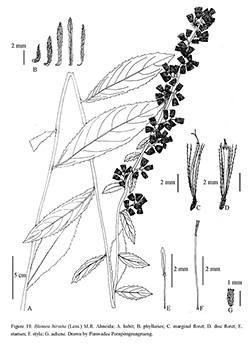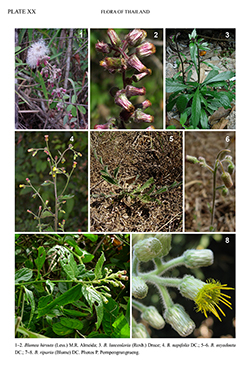e-Flora of Thailand
Volume 13 > Part 2 > Year 2016 > Page 211 > Compositae (Asteraceae) > Blumea
9. Blumea hirsuta (Less.) M.R.Almeidawfo-0000125203
Fl. Maharashtra 3A: 79. 2001.— Pluchea hirsuta Less. Linnaea 6: 150. 1831.— Blumea hirsuta (Less.) King-Jones, Englera 23: 120. 2001, nom. superfl. Fig. 19; Plate XX: 1–2.
Accepted Name : This is currently accepted.
Synonyms & Citations :
Description : Annual or perennial herb, 0.3–1.7 m tall; stems erect, with long pilose hairs. Leaves petiolate; oblong, obovate, oblanceolate or elliptic, 1.5–16 by 0.7–6 cm, apex acute or acuminate, base attenuate or cuneate, margins distantly serrate or dentate with mucronate teeth, both surfaces glabrous or with long scattered pilose hairs, without glandular hairs; petioles to 5 mm long. Inflorescences terminal and/or axillary, clusters forming a dense narrow panicle, 12–21 cm long. Capitula 5–8 mm diam., peduncles slender, to 5 mm long; involucres campanulate; phyllaries 5 (–7)-seriate, outer lanceolate with entire margins, 0.6–0.7 mm wide, pubescent, inner linear-oblong with ciliate margins, pilose; receptacle 3–5 mm diam., slightly convex, alveolate, densely pilose. Marginal floret corollas yellow, basal tube 5–6.3 mm long, lobes pubescent. Disc floret corollas yellow, basal tube 4.5–6 mm long, lobes 5(–6), oblong-lanceolate, 0.4–0.5 mm long, pubescent with multicellular hairs and glandular hairs; anthers 1–1.2 mm long, apical appendages truncate to emarginate, bases with unbranched tails, anther-tails shorter than anther collars; style arms 2, unequal, 0.6–1.5 mm long, base swollen. Achenes oblong, 10-ribbed, 1–1.3 by 5–6 mm, setuliferous; pappus bristles 19–20, 5–7.5 mm long, persistent, white.
Thailand : NORTHERN: Mae Hong Son (Muang Sroi Falls), Chiang Mai (Doi Mae Ya, Doi Suthep Pui NP, Mae Sao Watershed Management Station), Chiang Rai (Doi Tung), Tak (Doi Pha Hom); NORTH-EASTERN: Phetchabun (Nam Nao NP), Loei (Phu Luang, Phu Thong), Sakon Nakhon (Phu Phan NP); EASTERN: Nakhon Ratchasima (Khao Yai NP); SOUTH-WESTERN: Kanchanaburi (Song Tho, Thong Phaphum to Pilok), Ratchaburi (Bang Saphan); CENTRAL: Nakhon Nayok (Khao Yai NP); SOUTH-EASTERN: Chanthaburi (Khao Phrabat, Khitchakut NP, Khao Soi Dao North); PENINSULAR: Ranong (Khao Phota Chongdong), Phangnga (Takuapa, Naichong).
Distribution : China (Hainan, Guangdong, Hong Kong), India, Bhutan, Nepal, Myanmar, Indochina, Malaysia (Penang, Sabah), Indonesia (Borneo, Sumatra, Celebes, Java), the Philippines (Luzon, Mindanao).
Ecology : By roads in open dry evergreen forests, old clearings along edges of open evergreen forests or by streams in pine and dipterocarp forests, 10–1,300 m alt. Flowering: September–March.
Vernacular : Kanat (กะน๊าด)(Surat Thani).


